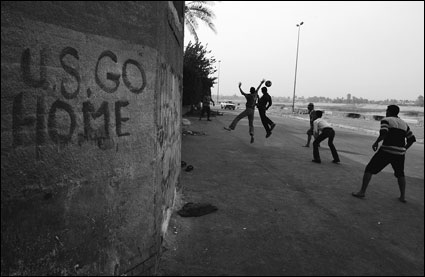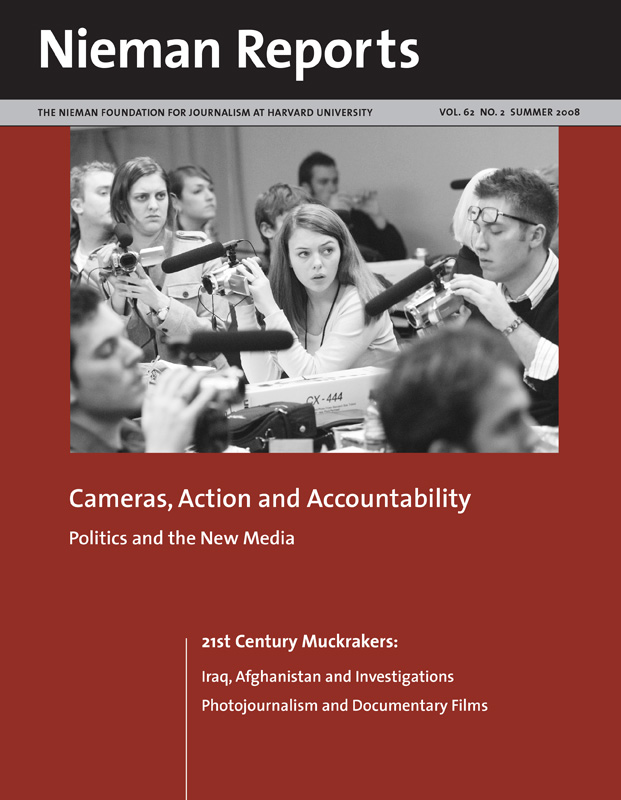Our documentary film, “Meeting Resistance,” about the people and make-up of the Iraqi resistance, was released in theaters last fall. Since then, we have shown the film in more than 80 U.S. cities, as well as to several key military audiences. We’ve made more than 200 appearances with the film to talk about our understanding of the conflict in Iraq and take questions from the audience.
When the lights come up after our film is shown, we are greeted with the kind of silence associated with people trying to reconcile what they thought they knew with what they now understand. From their feedback and questions, we’ve come to realize that our film, combined with our answers to their questions, is delivering a paradigm shift about the Iraq conflict — one audience at a time.
“Meeting Resistance” explores one of two wars being waged in Iraq — the popularly supported resistance to occupation, which contains the majority of the organized violence happening in Iraq. Using primary source material, critical analysis and cross-referencing, we crafted a film that tells the story of that conflict. The second war is the civil war — an internal political struggle being waged over competing visions of Iraq’s future, of which the country’s sectarian violence is a symptom, not a cause.
During 10 months — from August 2003 until May 2004 — we made daily trips primarily to the predominantly Sunni-Arab Adhamiya neighborhood of Baghdad, where we spoke with hundreds of the city’s residents. At least 45 of the individuals we spoke with claimed to be involved in the resistance. We were able to film testimony of eight of those people — including Sunni and Shiite Iraqis and a Syrian — in addition to two who provide essential context, an imam and a professor of political science who has spent his career at Baghdad University researching civil war and conflict.
What we were seeking through our on-the-ground reporting were some answers about who was behind the ongoing attacks against U.S. troops. When we began, we were unsure of where this question would lead us. As we gathered information, we crosschecked and analyzed what we were hearing from our sources, including information about weapons, funding, targeting, motivation and the role of religion, nationalism and revenge. Our film puts forth the essence of what we found.
Challenging the Narrative
“Meeting Resistance” is a journalistic documentary, not an advocacy or polemic film. Although we did not set out to challenge the narrative of the Iraq conflict — the one that has been constructed in Washington — our reporting eventually led us to do so. Our film has no narrator since we felt our sources were capable of speaking for themselves about this critical time in their country’s history. The lack of narration leaves the film’s viewers to draw their own conclusions about these individuals, the movement they represent, and what course of action the United States should take in Iraq.
Throughout the world’s history, there have been occupations — and resistance to those occupations. Why then do Americans have such a difficult time grasping that our troops are unwelcome by the vast majority of the Iraqi population? And why has reporting by our mainstream news media generally failed to recognize this Iraqi resistance and draw our attention to this central, core aspect of the violence?
Journalists who attended the U.S. military’s briefings in the Green Zone during 2003 and 2004 were told by U.S. political and military spokespeople that the violence against American troops came from “dead-enders” and “Baathi die hards,” from common criminals, religious extremists, foreign fighters, and al-Qaeda. This meant those engaged in the resistance were characterized as “fringe elements” of Iraqi society. While some fighters in Iraq might fit some of those descriptions, we found that the majority involved in the organized resistance are citizens from the core of Iraqi society.
In time, we came to see the U.S. military’s misnaming of the “enemy” as an intentional act — as a key part of their objective to control the “information battle space.” They aspire to control the perception of the enemy’s identity as well as the narrative about them, and through the news media persuade the American public that these “fringe elements” of Iraqi society are the only ones who oppose the U.S. presence in Iraq. A military push (or surge) to isolate and eliminate (to use military jargon) these “fringe elements” would accomplish, therefore, a perceived “victory.” By their willingness to convey this impression, many in the U.S. news media neglected their primary responsibility of informing the public.
From the Pentagon to Iraq
The National Intelligence Estimate on Iraq delivered to the White House in October 2003 was leaked in February 2006 by Robert Hutchings, the 2003-2005 chairman of the National Intelligence Council. In interviews with McClatchy about this intelligence estimate, Hutchings revealed that the U.S. intelligence community in 2003 understood the shape and make-up of the Iraqi resistance; the report said that it is composed of nationalists fighting for their country with deep roots in the society and that the U.S. military, if it remains in Iraq, will be fighting a counterinsurgency war for years to come. This conclusion echoed what we had found in our on-the-ground reporting for “Meeting Resistance.”
This spring, a New York Times front-page investigation revealed the Pentagon’s well-oiled “briefing” system for retired military analysts who are working for TV outlets and writing op-eds in ways that reflect and amplify the U.S. government’s narrative. The reporting done by the Times underscores the critical importance the Pentagon ascribes to its efforts to control the “message,” including how it defines the enemy.
The 2006 counterinsurgency (COIN) manual spells out the necessity of consistency in message across all targeted populations, including the U.S. civilian population, and the importance of message in “winning” a protracted counterinsurgency war. In the role they play in shaping the perception of the war, U.S. journalists have been subjected to similar press strategies, and not all reporters have been able to see these well-orchestrated information operations for what they are. As a result, this misleading narrative about Iraq has been constructed, based on reporters being fed this kind of self-serving information by the U.S. government. This has been a cause of what we call the “rational dissonance” that we encounter at the end of each screening of our film.
If the predominant narrative about the Iraq conflict was truly based in reality, then it would involve pointing out that the majority of Iraqis want a withdrawal of all foreign forces and that the Department of Defense’s quarterly reports to Congress, on average, show that from April 2004 to December 2007, 74 percent of significant attacks initiated by Iraqis targeted U.S.-led coalition forces. Americans would also find out that half of registered marriages in Baghdad in 2002 were mixed marriages between Sunni and Shia, Kurd and Arab, Christian and Muslim, and many of the tribes and clans and families are, in fact, mixed between Sunni and Shia. Also, nearly all of the Arab Iraqis polled oppose dividing the country along ethnic and sectarian lines, and the vast majority demand that Iraq have a strong central government, not the decentralized powerlessness imposed by the American-influenced constitution.
It is not that these points have never been reported. They have. But the booming voice of “disinformation” — from which the Pentagon expects the American public to absorb the narrative of the conflict — drowns out much of this information. Ultimately, what our independent reporting for this film has helped to reveal is the success of the Pentagon’s strategy to obscure the real nature of the war in Iraq. Unfortunately, many in the news media have been willing to allow that to happen.

The Iraqi resistance to the American occupation starts at street level, and an attitude of defiance reigns on the alleys and boulevards of Adhamiya. Here, a soccer team trains its goalie against a building’s wall inscribed with carefully painted anti-American graffiti. A few weeks later, in a pass by the same street that runs along the Tigris River, the graffiti had been painted over, presumably by American troops. Adhamiya, Baghdad, Iraq. November 12, 2003. Photo and text by Molly Bingham/WorldPictureNews.
Molly Bingham, a 2002 Nieman Fellow, and Steve Connors are directors of “Meeting Resistance,” distributed by First Run.


